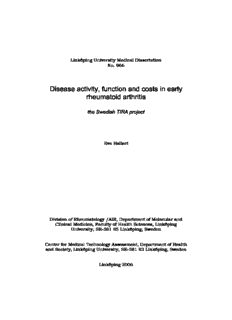
Disease activity, function and costs in early rheumatoid arthritis PDF
Preview Disease activity, function and costs in early rheumatoid arthritis
Linköping University Medical Dissertation No. 966 Disease activity, function and costs in early rheumatoid arthritis the Swedish TIRA project Eva Hallert Division of Rheumatology /AIR, Department of Molecular and Clinical Medicine, Faculty of Health Sciences, Linköping University, SE-581 85 Linköping, Sweden Center for Medical Technology Assessment, Department of Health and Society, Linköping University, SE-581 83 Linköping, Sweden Linköping 2006 © Eva Hallert, 2006 Published articles have been reprinted with the permission of the respective copyright holders. Annals of the Rheumatic Diseases / BMJ Publishing Group (Paper I), Rheumatology (Oxford) / Oxford University Press (Paper II and Paper III). Printed by LiU-Tryck, Linköping, Sweden, 2006 ISBN 91-85643-93-9 ISSN 0345-0082 To Claes Anna, Åsa, Sara and Erik CONTENTS ABSTRACT 7 ABBREVIATIONS 9 LIST OF ORIGINAL PUBLICATIONS 11 INTRODUCTION 13 Rheumatoid arthritis 13 Assessments 15 Disease activity 15 Function 16 Economic burden 17 General 17 Direct costs 18 Indirect costs 19 Intangible costs 19 Treatment 20 The Swedish TIRA project 20 AIMS OF THE STUDY 23 PATIENTS AND METHODS 25 Disease and disease activity 26 Function and general health 27 Health care questionnaire 28 Statistical analyses 29 RESULTS 31 Course of disease and function (papers I and III) 31 Costs and predictors of costs (paper II) 33 Costs over 3 years (paper III) 36 Early predictors of TNF-targeted therapy (paper IV) 40 DISCUSSION 47 Disease and function (papers I and III) 47 Direct and indirect costs and predictors of high costs (papers II and III) 50 Predictors of TNF-targeted therapy (paper IV) 57 CONCLUSIONS 59 SUMMARY IN SWEDISH/SAMMANFATTNING PÅ SVENSKA 61 ACKNOWLEDGEMENTS 63 REFERENCES 67 ABSTRACT Rheumatoid arthritis (RA) is a major cause of progressive joint damage and disability, and is associated with decline in quality of life, reduced ability to work and increased health care utilisation. The economic consequences of the disease are substantial for the individuals and their families and for the society as a whole. This thesis describes a 5- year follow up of 320 patients with early RA, enrolled between January 1996 and April 1998 in the Swedish multi-centre inception cohort TIRA (early interventions in rheumatoid arthritis). Health status, function and costs were investigated. Predictors of high costs were calculated, and an algorithm was constructed to predict future need for TNF-inhibitor treatment in patients not responding to traditional disease-modifying antirheumatic drugs (DMARDs). Clinical and laboratory data, measuresof functional capacity and self- reported assessments were collected regularly. In addition, patients completed biannual/annual questionnaires concerning all health care utilisation and days lost from work due to the disease. Within 3 months, improvements were seen regarding all variables assessing disease activity and functional ability, but 15% of the patients had sustained high or moderate disease activity throughout the study period. The scores of ‘health assessment questionnaire’ (HAQ) were similar for men and women at baseline, but had a less favourable course in women, who also had DMARDs more frequentlyprescribed. Ambulatory care accounted for 76% of the direct costs during the first year. Women had more ambulatory care visits and higher usage of complementary medicine compared to men. Men (cid:149)65 years had low costs compared to younger men and compared to women of all ages. In multiple logistic regression tests, HAQ, high levels of IgM-class rheumatoid factor (RF), and poor hand function increased the odds of incurring high direct costs. Poor hand function and pain increased the odds of incurring high indirect costs. Indirect costs exceeded direct costs all three years. The average direct costs were €3,704 (US$ 3,297) year 1 and €2,652 (US$ 2,360) year 3. All costs decreased over the years, except those for medication and surgery. The indirect costs were €8,871 (US$ 7,895) year 1 and remained essentially unchanged, similarly for both sexes. More than 50% were on sick leave or early retirement at inclusion. Sick leave decreased but was offset by increase in early retirement. 14 patients (5%) were prescribed TNF-inhibitors at the 3-year follow up, thus increasing drug costs substantially. However, they incurred higher costs even before prescription of anti- TNF therapy. At the 5-year follow-up (2001-2003), 31 patients (12%) were prescribed TNF-inhibitors. Baseline values of erythrocyte 7 sedimentation rate, C-reactive protein, anti-CCP antibodies and morning stiffness were significantly higher in this group. These patients were also to a larger extent RF-positive and carriers of the ‘shared epitope’ (SE). Anti-TNF treated patients were significantly younger and more often women. For men, a predictive model was constructed using baseline data including SE+ and IgA-RF >100 U/L and anti-CCP >240 U/L yielding a specificity of 98% and a sensitivity of 71%. For women, disease activity score (DAS28) at the 3-month follow-up proved to be a better predictor, and the final model comprised SE+ and 3-month DAS28>5.2, giving a specificity of 95% and a sensitivity of 59%. 8 ABBREVIATIONS ACR American College of Rheumatology Anti-CCP anti-cyclic citrullinated peptide ACPA antibodies against citrullinated peptides/proteins ARA American Rheumatism Association CAM complementary medicine CI confidence interval CRP C-reactive protein DAS28 28-joint count disease activity score DMARD disease-modifying antirheumatic drug ELISA enzyme-linked immunosorbent assay ESR erythrocyte sedimentation rate EULAR European League Against Rheumatism FCA friction cost approach HAQ Stanford Health Assessment Questionnaire HCA human capital approach HLA human leukocyte antigen ICF International Classification of Functioning, Disability, and Health Ig immunoglobulin MCP metacarpophalangeal (joint) MTP metatarsophalangeal (joint) NSAID non-steroidal anti-inflammatory drug OMERACT Outcome Measures for Arthritis Clinical Trials OR odds ratio OT occupational therapist PIP proximal interphalangeal (joint) PGA physician’s global assessment of disease activity PT physiotherapist RA rheumatoid arthritis RF rheumatoid factor ROC receiver operating curve SD standard deviation SE shared epitope SEK Swedish kronor SEM standard error of the mean SOFI Signals of Functional Impairment TIRA Swedish acronym for ‘early intervention in RA’ TNF tumor necrosis factor VAS visual analogue scale WHO World Health Organization 9
Description: